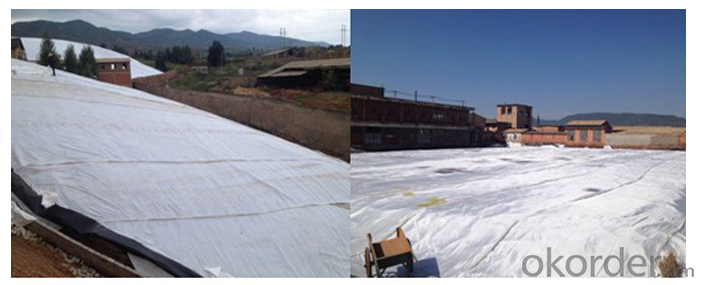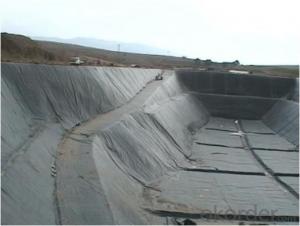Nonwoven Geotextile For Construction & Real Estate
- Loading Port:
- Tianjin
- Payment Terms:
- TT OR LC
- Min Order Qty:
- 5000 g/m²
- Supply Capability:
- 10000 g/m²/month
OKorder Service Pledge
OKorder Financial Service
You Might Also Like
Packaging & Delivery
| Packaging Detail: | packing with customer requests |
| Delivery Detail: | after we have received you payment |
Specifications
Biaxial geogrid:
1)Raw material: Polyproplene;
2)Width: 1.6~2.5m;
3)High Tensile strength

The mateiral of biaxial tension plastic geogrid is similar with the material of unidirectional tension plastic geogrid. Its chemical property isn't active also. It is extruded by macromolecule polymers, and formed by longitudinal and horizontal tension. This kind of material has high tension strength in both longitudinal and horizontal directions. This kind of structure provides a interlock system for the soil.

| Item | TGSG15 | TGSG20 | TGSG30 | TGSG40 | TGSG45 |
| Longitudinal tensile yield strength per long meter | 15 | 20 | 30 | 40 | 45 |
| Horizontal tensile yield strength per long meter | 15 | 20 | 30 | 40 | 45 |
| longitudinal yield elongation rate | 13 | ||||
| Horizontal yield elongation rate | 16 | ||||
| longitudinal resistance to 2%of deformation | 5 | 8 | 11 | 13 | 16 |
| Horizontal resistance to 5%of deformation | 7 | 10 | 13 | 15 | 20 |
| longitudinal resistance to5%of deformation | 8 | 10 | 15 | 16 | 25 |
| Horizontal resistance to 5%of deformation | 10 | 13 | 15 | 20 | 22 |

(1) Road surface reinforcement of road,railway and airport road;
(2)Maintenance,reconstruction and widening of old road surface(asphaltum road or cement concrete road).
(3)Reinforcement of soft soil roadbed,irrigation channels and water dam.
A. Filtration
The filtration layer of the dykes, river canal, seacoast, concrete slope, retaining walls.
At the same time of preventing the clay granule from passing, it allows the water and the gas pass through freely.
B. Separations:
The isolation of the railway dregs and the roadbed, roadbed and the soft base, different dam materials.
It isolates the soil and the gravel of two kinds different granule pathway from the groundsill or other buildings.
C. Adding muscle:
The highway, railway of retaining wall, slope protection, etc in which distributes the earth stress,
prevents the side-displacement of the earth body and improves the earth body stability.
D. Protections
It prevents the bank from being washed out, protects the bank and the bottom,
prevents the water and soil from being washed away.

FAQ:
♦ Payment terms: by T/T or L/C |
♦ MOQ:2000 SQM |
♦ If you are interested in our products ,pls advice me the technical index,product weight etc,the more information the better..... |
- Q:Can geotextiles be used in coastal dune stabilization projects?
- Yes, geotextiles can be used in coastal dune stabilization projects. These woven or non-woven fabrics can be employed to reinforce and stabilize sand dunes by trapping and retaining sand particles, preventing erosion caused by wind and water. Geotextiles offer a cost-effective and environmentally friendly solution for maintaining the integrity and resilience of coastal dunes, protecting them from erosion and promoting sustainable coastal management.
- Q:Geomembrane upstream protective layer with what material? The Why can not you use clay?
- With geotextile to do protective layer, because the geotextile and geomembrane as with acid and alkali, is the characteristics of corrosion, the useful life of more than 50 years can better protect the geomembrane. Clay and its performance is far from the comparison, so the use of geotextile hides to avoid waste Zhuan belly over the sand to make the upper reaches of the protective layer. Inquire about Yinjing Li
- Q:What are the specifications for geotextiles in wastewater treatment projects?
- The specifications for geotextiles in wastewater treatment projects typically involve factors such as the material type, weight, thickness, permeability, and strength. These geotextiles are commonly required to have high tensile strength, puncture resistance, and durability to withstand the harsh conditions of wastewater treatment facilities. Additionally, they should have a specific permeability to allow for proper filtration and drainage of water while preventing the passage of fine particles.
- Q:What are the factors to consider when selecting geotextiles?
- When selecting geotextiles, factors to consider include the desired application, site conditions, required strength and durability, permeability, cost, and environmental considerations.
- Q:How do geotextiles help in gas venting?
- Geotextiles help in gas venting by allowing the passage of gases through their porous structure while preventing the migration of soil particles. These textiles are used as a barrier or filter to control the movement of gases, such as methane, in areas where gas buildup can be hazardous, such as landfills or contaminated sites. The geotextiles allow the gas to escape, reducing the risk of explosions or other safety hazards, while still providing stability and support to the surrounding soil.
- Q:What are the benefits of using geotextiles in road construction?
- Geotextiles offer several benefits in road construction, including improved soil stabilization, increased road lifespan, and enhanced drainage. These synthetic fabrics act as a barrier, preventing the mixing of different soil layers, which helps to maintain the road's structural integrity. Geotextiles also provide reinforcement by distributing the load more evenly, reducing the occurrence of cracks and potholes. Additionally, these materials enhance drainage by allowing water to pass through while retaining the soil particles, preventing erosion and waterlogging. Overall, geotextiles contribute to cost-effective and sustainable road construction.
- Q:Please geotextile manufacturers offer,
- Please geotextile manufacturers offer,
- Q:What are the considerations for geotextile selection in mining operations?
- When selecting geotextiles for mining operations, several key considerations should be taken into account. These include the specific requirements of the mining site, such as the type of minerals being mined and the environmental conditions present. The geotextile's strength and durability are crucial factors, as it needs to withstand the heavy loads and harsh conditions associated with mining activities. Additionally, the geotextile's filtration properties and permeability should be assessed, as they play a vital role in controlling water flow and preventing soil erosion. Compatibility with other materials and the cost-effectiveness of the geotextile should also be considered during the selection process. Overall, choosing the right geotextile for mining operations requires a comprehensive evaluation of the site's unique characteristics and performance requirements.
- Q:Waterproof and protective layer between which type of geotextile isolation layer
- Personally think to take impervious geotextile. Anti-seepage geotextile has excellent water permeability, filterability, durability, can be widely used in railways, highways, sports museum, dams, hydraulic construction, then hole, coastal beach, reclamation, environmental protection and other projects. Mainly staple acupuncture non-woven geotextile and split film woven geotextile. Check the original post & gt; & gt; trouble to adopt, thank you!
- Q:What are the cost implications of using geotextiles?
- The cost implications of using geotextiles can vary depending on factors such as the type and quality of the geotextile, the size of the project, and the specific application. In general, geotextiles can add an additional cost to a project, as they need to be purchased and installed. However, they can also provide cost savings in the long run by reducing the need for expensive soil stabilization measures, increasing the lifespan of structures, and minimizing maintenance and repair costs. Additionally, geotextiles can provide cost-effective solutions for erosion control, slope stabilization, and drainage, which can help prevent costly damages and disruptions.
1. Manufacturer Overview |
|
|---|---|
| Location | |
| Year Established | |
| Annual Output Value | |
| Main Markets | |
| Company Certifications | |
2. Manufacturer Certificates |
|
|---|---|
| a) Certification Name | |
| Range | |
| Reference | |
| Validity Period | |
3. Manufacturer Capability |
|
|---|---|
| a)Trade Capacity | |
| Nearest Port | |
| Export Percentage | |
| No.of Employees in Trade Department | |
| Language Spoken: | |
| b)Factory Information | |
| Factory Size: | |
| No. of Production Lines | |
| Contract Manufacturing | |
| Product Price Range | |
Send your message to us
Nonwoven Geotextile For Construction & Real Estate
- Loading Port:
- Tianjin
- Payment Terms:
- TT OR LC
- Min Order Qty:
- 5000 g/m²
- Supply Capability:
- 10000 g/m²/month
OKorder Service Pledge
OKorder Financial Service
Similar products
New products
Hot products
Hot Searches
Related keywords






























